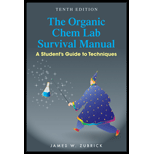
Concept explainers
Interpretation:
If someone has put about one-quarter of an inch of solid in the tube, should they go for an eye exam is to be explained.
Concept Introduction:
The melting point of a substance is the temperature at which it changes state from solid to liquid. This change occurs in atmospheric pressure and during melting point the two phases (solid and liquid) exist in equilibrium.
Nowadays in laboratory lots of equipment is available for determine the melting point of substance.
Put the correct amount of a solid in a melting-point tube.
Answer to Problem 1E
The person should carefully put the correct amount of sample in the tube.
Yes the person should go for an eye exam, if someone has put about one-quarter of an inch of solid in the tube due to weak eyesight.
Explanation of Solution
A melting point is the temperature at which the first crystal just starts to melt until the temperature at which the last crystal just disappears. Take melting points only on dry, solid substances, never on liquids or solutions of solids in liquids or on wet or even damp solids.
Use only the smallest amount that you can see melt because larger samples will heat unevenly. The person should carefully put the correct amount of sample in the tube.
Yes the person should go for an eye exam, if he/she has put about one-quarter of an inch of solid in the tube due to weak eyesight.
Want to see more full solutions like this?
Chapter 12 Solutions
The Organic Chem Lab Survival Manual: A Student's Guide to Techniques
- How much solid should be placed in a melting-point capillary tube?arrow_forward3.Why is slow cooling required to produce pure crystals?arrow_forwardA student was trying to prepare acetaminophen in the laboratory. She found a melting point range of 169-173. The melting of acetaminophen is reported to be 168-172c. How could the student have verified that the produce is acetaminophen? Retake the sample melting point with more material in the sample. Ask the lab partner to measure the melting point of the sample. Take a mixed melting point with an authentic sample of acetaminophenarrow_forward
- If each edge is 1 cm. How much liquid does this shape holdarrow_forwardQ1/Why do we use oil instead of water to determine the melting point of chemicals? Q2/What is the reason for the variation in the measured melting point of the same chemical? Q3/What is the best type of oil used to measure the melting point of chemicals? Why?arrow_forwardI only need help with questions three, please solve but always explain. I am not sure what the question is asking, and no other techniques come to mind when thinking about how to dry crystals more.arrow_forward
- Cite some possible applications of determining the melting point of a substance. Explain briefly.arrow_forwardAt about what temperature does the sample change phase? Justify your Answer based on the cooling curve shown above.arrow_forward29- The property of liquids that explains the formation of water droplets on a polished surface is called:Unique option. A) Surface tension B) Capillarity C) Viscosity D) Osmosis E) Fluencyarrow_forward
- Water rises in a glass capillary tube to a height of 17 cm. What is the diameter of the capillary tube?arrow_forwardA student was trying to prepare acetaminophen in the laboratory. She found a melting point range of 169-173. The melting of acetaminophen is reported to be 168-172c. How could the student have verified that the produce is acetaminophen? Group of answer choices. Retake the sample melting point with more material in the sample. Ask the lab partner to measure the melting point of the sample. Take a mixed melting point with an authentic sample of acetaminophenarrow_forwardTwo samples have exacted the 1 point same melting points, so the samples are: If the mixture has the same melting point of the two samples then the compounds identical to each other (Same compounds). The same intermolecular forces. The same structure Different to each other's.arrow_forward
 Macroscale and Microscale Organic ExperimentsChemistryISBN:9781305577190Author:Kenneth L. Williamson, Katherine M. MastersPublisher:Brooks Cole
Macroscale and Microscale Organic ExperimentsChemistryISBN:9781305577190Author:Kenneth L. Williamson, Katherine M. MastersPublisher:Brooks Cole EBK A SMALL SCALE APPROACH TO ORGANIC LChemistryISBN:9781305446021Author:LampmanPublisher:CENGAGE LEARNING - CONSIGNMENT
EBK A SMALL SCALE APPROACH TO ORGANIC LChemistryISBN:9781305446021Author:LampmanPublisher:CENGAGE LEARNING - CONSIGNMENT Chemistry by OpenStax (2015-05-04)ChemistryISBN:9781938168390Author:Klaus Theopold, Richard H Langley, Paul Flowers, William R. Robinson, Mark BlaserPublisher:OpenStax
Chemistry by OpenStax (2015-05-04)ChemistryISBN:9781938168390Author:Klaus Theopold, Richard H Langley, Paul Flowers, William R. Robinson, Mark BlaserPublisher:OpenStax Chemistry: The Molecular ScienceChemistryISBN:9781285199047Author:John W. Moore, Conrad L. StanitskiPublisher:Cengage LearningChemistry: Matter and ChangeChemistryISBN:9780078746376Author:Dinah Zike, Laurel Dingrando, Nicholas Hainen, Cheryl WistromPublisher:Glencoe/McGraw-Hill School Pub Co
Chemistry: The Molecular ScienceChemistryISBN:9781285199047Author:John W. Moore, Conrad L. StanitskiPublisher:Cengage LearningChemistry: Matter and ChangeChemistryISBN:9780078746376Author:Dinah Zike, Laurel Dingrando, Nicholas Hainen, Cheryl WistromPublisher:Glencoe/McGraw-Hill School Pub Co





